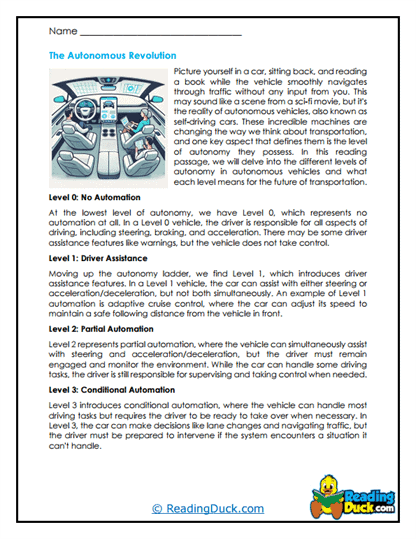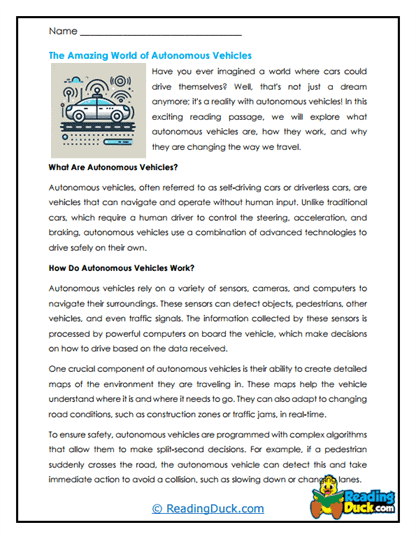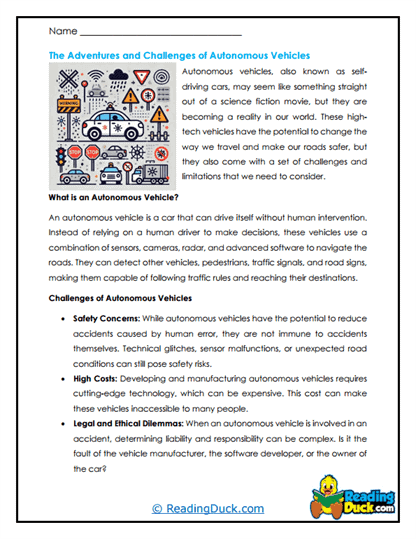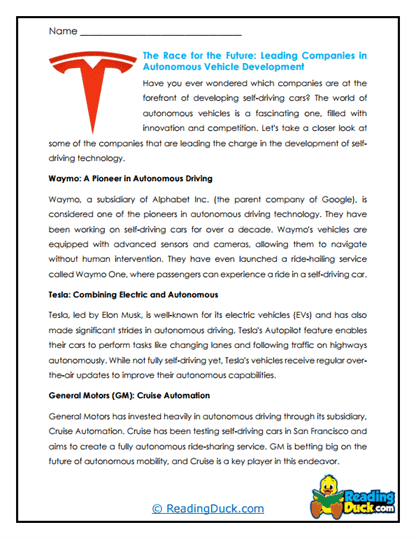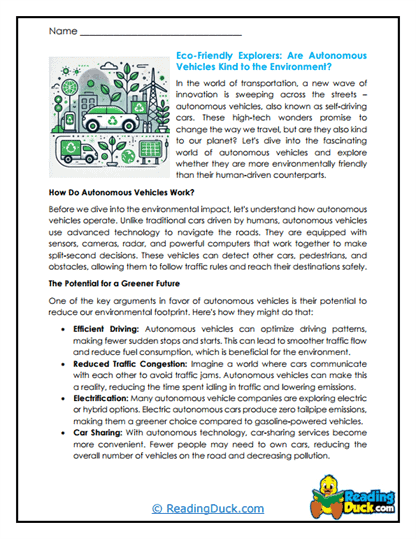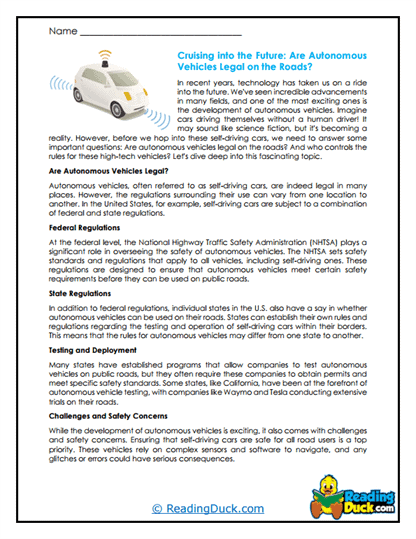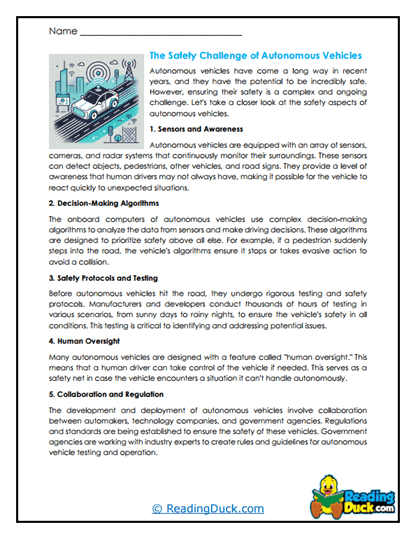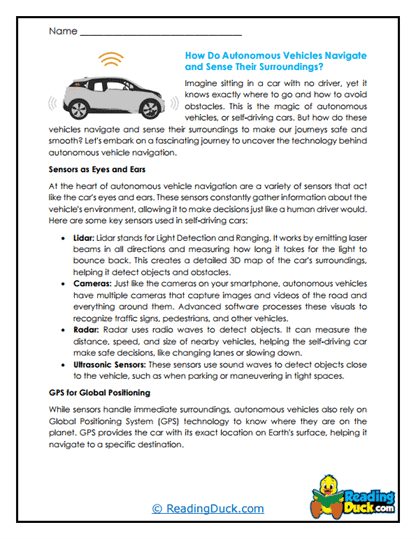Autonomous Vehicles Worksheets
About Our Autonomous Vehicles Worksheets
Our Autonomous Vehicles Worksheets provide an engaging and comprehensive introduction to one of the most cutting-edge technologies shaping the future of transportation. These worksheets are crafted to help students understand the principles, technology, and implications of autonomous vehicles, from how they operate to their potential impact on society. Each worksheet set is designed to captivate students' interest while deepening their knowledge of this rapidly evolving field.
Every worksheet set in this collection includes:
- Multiple Choice Questions: These questions assess students' comprehension of key concepts, ensuring they understand the essential elements of autonomous vehicle technology.
- Short Answer Questions: These prompts require students to express their understanding in their own words, encouraging deeper reflection and clear articulation of their thoughts.
- Open-Ended Questions: These questions invite students to explore their personal opinions, preferences, and predictions related to the material, fostering a more meaningful connection with the topic.
To enhance learning, an answer key is provided for every question sheet. All of the worksheets are available in PDF format, making them easy to download, view electronically, and print out for classroom or home use.
Understanding Autonomous Vehicles: The Future of Transportation
Autonomous vehicles, also known as self-driving cars, represent a significant leap forward in transportation technology. These vehicles are equipped with advanced sensors, artificial intelligence (AI), and machine learning algorithms that enable them to navigate roads, detect obstacles, and make driving decisions without human intervention. The technology behind autonomous vehicles is not only fascinating but also has the potential to revolutionize how we think about transportation, safety, and urban planning.
Key Concepts in Autonomous Vehicle Technology
To truly grasp the importance and potential of autonomous vehicles, it’s crucial to understand the core components that make these vehicles function. Our worksheets introduce students to several key concepts:
- Sensors and Perception: Autonomous vehicles rely on an array of sensors, including cameras, lidar, radar, and ultrasonic sensors, to perceive their environment. These sensors work together to create a detailed 3D map of the surroundings, allowing the vehicle to detect and respond to objects, pedestrians, and other vehicles.
- Artificial Intelligence and Machine Learning: AI is at the heart of autonomous vehicles. It processes the data collected by sensors, enabling the vehicle to understand its environment, predict the behavior of other road users, and make decisions in real-time. Machine learning algorithms allow these systems to improve over time by learning from experience.
- Autonomous Driving Levels: The Society of Automotive Engineers (SAE) has defined six levels of driving automation, ranging from Level 0 (no automation) to Level 5 (full automation). Understanding these levels helps students grasp the different stages of autonomy that vehicles can possess.
- Safety and Ethics: The deployment of autonomous vehicles raises important ethical questions and safety concerns. Students will explore these issues, including the challenges of programming vehicles to make moral decisions in critical situations and the implications for public safety.
Applications and Implications of Autonomous Vehicles
The impact of autonomous vehicles extends far beyond just driving. These worksheets delve into the wide-ranging applications and implications of this technology, helping students appreciate its broader significance:
- Urban Planning and Traffic Management: Autonomous vehicles have the potential to reduce traffic congestion, improve road safety, and optimize urban infrastructure. This could lead to the development of smart cities where transportation is more efficient and sustainable.
- Environmental Impact: With the integration of electric propulsion systems, autonomous vehicles could significantly reduce greenhouse gas emissions and reliance on fossil fuels, contributing to a cleaner environment.
- Economic Implications: The rise of autonomous vehicles could disrupt several industries, including trucking, taxi services, and car manufacturing. Students will explore how this technology might create new job opportunities while also posing challenges for certain sectors.
- Accessibility and Mobility: Autonomous vehicles could provide greater independence and mobility to individuals who are unable to drive, such as the elderly and disabled. This aspect of the technology has the potential to enhance social inclusion and improve quality of life for many.
These real-world applications help students understand the far-reaching effects of autonomous vehicle technology, inspiring them to think critically about the future of transportation and their role in shaping it.
The Future of Autonomous Vehicles
As autonomous vehicle technology continues to evolve, its future holds exciting possibilities. The worksheets guide students through discussions on emerging trends and the future of autonomous vehicles, including:
- Integration with Smart Infrastructure: Autonomous vehicles could eventually communicate with smart traffic lights, road sensors, and other vehicles to create a fully connected transportation network.
- Autonomous Public Transportation: The development of autonomous buses, shuttles, and even drones for delivery services could revolutionize public transportation and logistics.
- Global Adoption and Challenges: While autonomous vehicles have the potential to improve transportation worldwide, their adoption will vary based on factors such as infrastructure, regulations, and public acceptance. Students will consider these challenges and what it might take for autonomous vehicles to become a global standard.
Creative Uses for These Worksheets
Incorporating Autonomous Vehicles Worksheets into your curriculum or homeschool setup can greatly enrich students’ understanding of this futuristic technology and spark a deeper interest in STEM subjects. Here are some practical and creative ways to use these worksheets effectively:
1. Hands-On Projects with Mini Autonomous Vehicles Encourage students to apply what they’ve learned by building or programming mini autonomous vehicles using robotics kits. This hands-on project allows them to experiment with sensors, coding, and problem-solving, providing a practical understanding of how autonomous vehicles operate.
2. Cross-Curricular Integration Integrate the autonomous vehicle worksheets with other subjects to create interdisciplinary learning experiences. For example:
- Physics: Explore the principles of motion, force, and energy that are fundamental to vehicle dynamics and sensor technology.
- Mathematics: Discuss the algorithms and data processing techniques that autonomous vehicles use, emphasizing the importance of statistics and geometry in real-world applications.
- Ethics and Social Studies: Dive into the ethical dilemmas and societal impacts of autonomous vehicles, encouraging students to think critically about the broader implications of technology.
3. Group Discussions and Debates Use the open-ended questions as prompts for group discussions or debates. Topics could include the ethical challenges of autonomous vehicles, the potential for job displacement, or the environmental benefits of electric autonomous cars. This will help students develop their communication and critical thinking skills.
4. Virtual Field Trips Leverage online resources to give students a virtual tour of companies and research institutions that are pioneering autonomous vehicle technology. Watching videos or taking virtual tours of facilities like Tesla, Waymo, or university robotics labs can provide a real-world connection to the concepts they’ve studied.
5. Creative Writing and Storytelling Encourage students to write a short story or essay imagining a day in the life with autonomous vehicles. This creative exercise allows students to think about the potential societal changes and personal experiences that could arise from widespread adoption of this technology.
6. Guest Speakers and Webinars Invite experts in the field of autonomous vehicles, such as engineers, data scientists, or ethicists, to speak with your students via video call. Students can prepare questions based on the worksheets, making the session more interactive and relevant.
7. Interactive Quizzes and Simulations Incorporate interactive quizzes or simulations to review and apply the material covered in the worksheets. There are online platforms where you can create custom quizzes or simulations that make learning about autonomous vehicles more engaging and interactive.
8. Parent and Community Involvement Encourage students to discuss what they’ve learned about autonomous vehicles with their parents or community members. They can present their knowledge through a mini-project, such as a poster or presentation, fostering a broader conversation about the future of transportation.
9. Research Projects on Emerging Technologies Use the autonomous vehicles worksheets as a starting point for deeper research projects on related emerging technologies, such as electric vehicles, smart cities, or AI-driven traffic management systems. This can help students see the interconnectedness of different technological fields and their collective impact on society.
10. Showcase Student Work Display students’ work related to autonomous vehicles, such as their creative writing pieces, research projects, or robotics experiments, in a classroom or virtual gallery. This not only motivates students to do their best work but also allows them to take pride in their achievements and learn from each other.
By integrating these Autonomous Vehicles Worksheets into your teaching strategy, you can create an engaging and forward-thinking learning environment that not only educates students about one of the most exciting areas of technology but also encourages them to think critically about its future implications. These worksheets are designed to be versatile and accessible, making them a valuable resource for educators aiming to prepare students for a world increasingly influenced by advanced technologies like autonomous vehicles.
